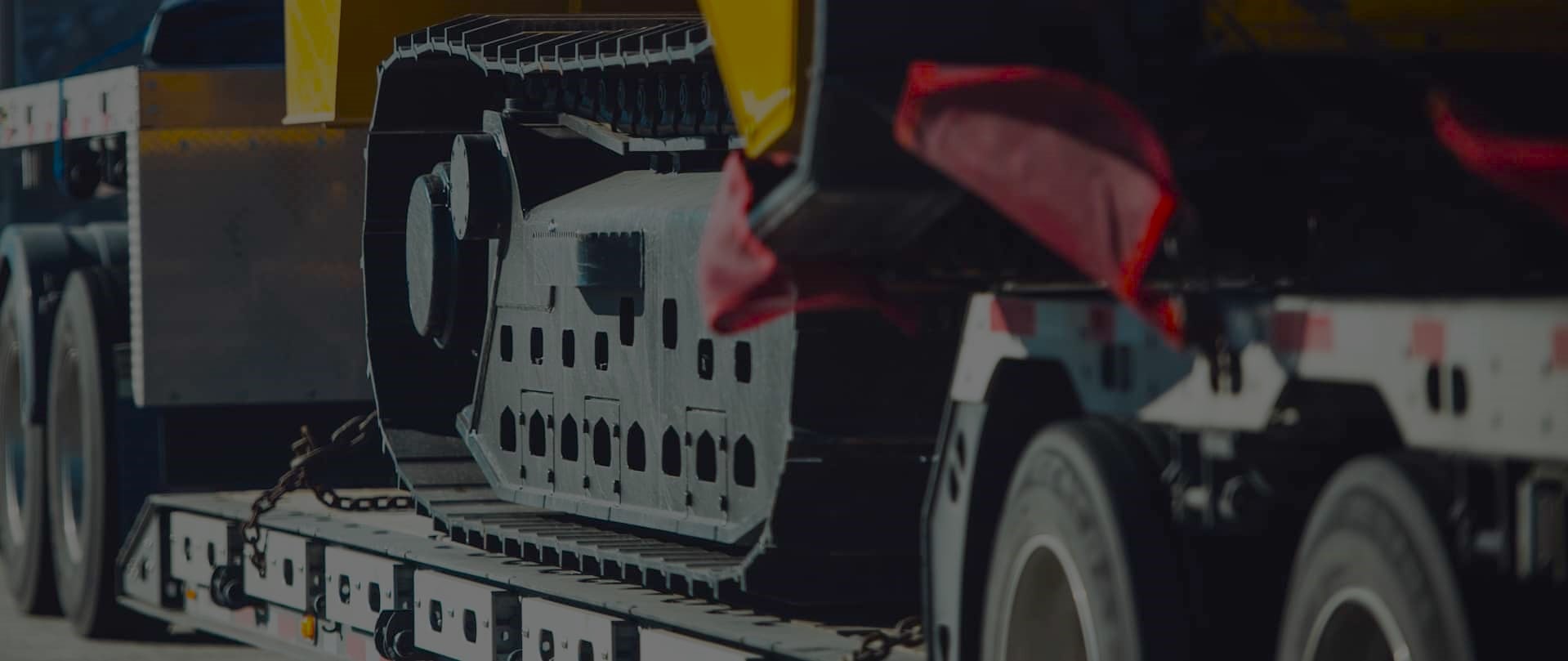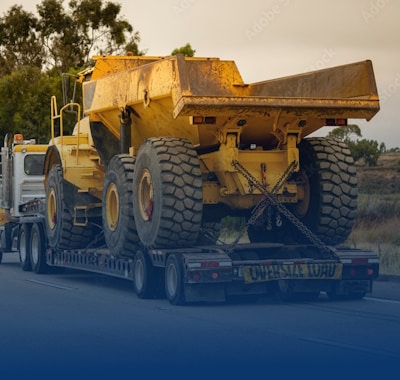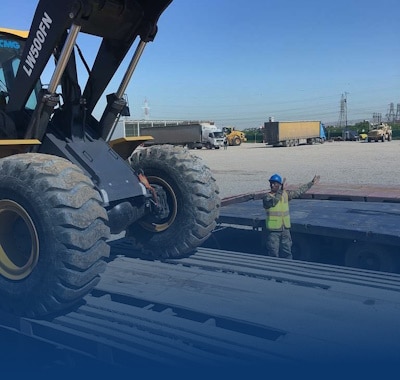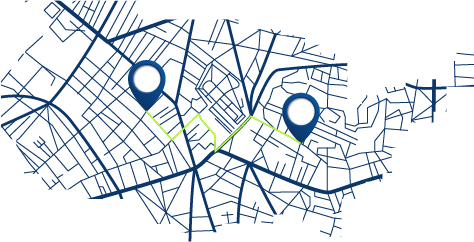How to Forecast Delivery Times for Complex Hauls: Our Guide
Freedom Heavy Haul can offer expedited Pickup and Delivery for any size shipment anywhere in the USA. Contact us today for No Hassle, No Pressure Pricing.
Accurate planning for oversized shipments requires more than traditional methods. Modern logistics demand AI-driven strategies that adapt to dynamic challenges, from route obstacles to shifting weather patterns. We specialize in transforming these complexities into predictable outcomes.
Advanced analytics now power data-rich decision-making, merging historical patterns with real-time variables. For example, Talonic’s AI-driven platform reduces delays by 23% through predictive traffic modeling. This approach reshapes how businesses manage high-stakes transports.
Our guide draws from decades of industry expertise and real-world case studies. You’ll discover how integrating machine learning with operational data creates resilient supply chains. These systems don’t just react – they anticipate disruptions before they occur.
The global marketplace rewards those who minimize uncertainty. With 68% of logistics leaders prioritizing predictive tech, staying competitive means embracing innovation. We’ll show you how to turn potential setbacks into strategic advantages.
Every paragraph ahead builds toward actionable insights. From route optimization frameworks to risk mitigation tactics, we provide the tools to elevate your operations. Let’s navigate the future of heavy haul logistics together.
Understanding the Complexity of Forecasting Delivery Times
Every mile in heavy hauling carries hidden variables that defy simple calculations. Unlike standard shipments, oversized loads face shifting risks – a single weather front or traffic bottleneck can unravel meticulously crafted schedules. We’ve seen projects derailed by factors as unpredictable as bridge height discrepancies and sudden permit changes.
Key Challenges in Managing Complex Hauls
Traffic patterns alone account for 37% of schedule disruptions in industrial transport. Congestion data becomes obsolete within hours, requiring dynamic management strategies. Last year, a Midwest wind turbine delivery faced 19-hour delays when construction rerouted traffic without warning.
Weather amplifies these risks. Rain reduces safe travel speeds for heavy loads by 40%, while crosswinds above 30 mph halt operations entirely. Sensor-equipped fleets now feed real-time road temperature data to planners, enabling last-minute route adjustments.
Unique Aspects of Delivery Time Predictions
Internal fleet capabilities directly impact timelines. A 2023 study revealed companies using machine learning for maintenance predictions achieved 68% higher on-time performance. Equipment readiness matters as much as external conditions.
Third-party dependencies create silent bottlenecks. Permit approval timelines vary by 300% across states, and escort vehicle availability fluctuates seasonally. Our systems cross-reference 14 regulatory databases to flag potential authorization delays before contracts are signed.
By treating each shipment as a unique ecosystem of variables, we transform chaotic logistics into controlled processes. The next sections reveal how to harness these insights through targeted technologies.
Leveraging Data Analytics for Improved Forecasting
Modern logistics thrives on transforming raw numbers into strategic foresight. Our teams combine decades of operational knowledge with cutting-edge analytics platforms, turning fragmented datasets into coherent action plans. This fusion of experience and technology reshapes how industries approach transport timelines.
The Role of Historical Data and Trends
Patterns from past shipments reveal hidden vulnerabilities. One Midwest operator slashed weather-related delays by 18% after analyzing five years of winter transport information. Their system now flags high-risk dates using historical storm frequency maps and driver performance metrics.
Machine learning models digest years of permit approval rates, creating predictive timelines for regulatory hurdles. When a Texas energy firm applied these insights, they reduced authorization wait times by 22% across three states.
Integrating Real-Time and Sensor Data
Live information streams from IoT devices enable mid-route corrections. GPS trackers and weight sensors alert planners to potential route issues before drivers encounter them. During a recent Colorado wind farm project, real-time tire pressure alerts prevented six potential roadside breakdowns.
Dynamic analytics tools merge traffic cameras with weather satellites. A Louisiana heavy hauler avoided 14 hours of delays by rerouting around a developing storm system detected through live atmospheric sensors. Their system recalculated ETAs every 90 seconds, maintaining client trust despite chaotic conditions.
Harnessing AI and Machine Learning in Logistics
Transportation planning enters a new era with algorithms that learn from every shipment. We deploy self-improving systems that analyze millions of data points to predict outcomes humans might miss. These tools don’t just process information – they evolve with each delivery cycle.
Predictive Analytics and Algorithm Innovations
Advanced models like ARIMA and KNN process historical patterns at lightning speed. Deep learning networks cross-reference weather archives with traffic sensor feeds. A Midwest logistics firm reduced rerouting decisions from 45 minutes to 8 seconds using these neural networks.
| Traditional Methods | AI-Driven Solutions |
|---|---|
| Static route planning | Dynamic path optimization |
| Manual delay tracking | Automated risk alerts |
| Monthly reports | Live ETA updates |
Examples of AI Applications in Route Planning
Texas energy transporters now avoid 73% of weather-related stoppages using satellite-fed prediction tools. Their systems adjust routes when sensors detect rising wind speeds or pavement temperature shifts.
Another breakthrough comes from Georgia-based fleets using machine learning to balance speed and fuel efficiency. Their algorithms saved 11,000 gallons of diesel last quarter while maintaining delivery windows. These solutions prove technology’s power to solve persistent industry problems.
As logistics evolves, early adopters gain decisive advantages. Our teams integrate these innovations to create resilient networks ready for tomorrow’s challenges. The future belongs to those who let data lead the way.
How to Forecast Delivery Times for Complex Hauls
Mastering timeline predictions requires merging precision tools with operational wisdom. Our approach transforms chaotic variables into structured workflows through six proven stages.
Step-by-Step Forecasting Techniques
Start with multi-source data aggregation. Sensor feeds, historical permits, and driver logs form the foundation. Clean datasets remove outliers like false GPS pings or incomplete maintenance records.
Next comes model training using normalized inputs. We balance variables:
- Route complexity scores
- Equipment maintenance cycles
- Real-time weather thresholds
| Traditional Approach | Modern Solution |
|---|---|
| Manual data entry | Automated API integrations |
| Fixed schedules | Dynamic time buffers |
| Generic risk profiles | Product-specific threat models |
Validation separates theory from reality. Compare predicted vs actual arrival times across 50+ shipments. One Midwest operator achieved 91% accuracy after refining their validation protocol.
Continuous adjustment keeps models sharp. Our teams recalibrate algorithms using:
- Daily traffic pattern updates
- Hourly weather satellite feeds
- Live bridge clearance reports
Implement these steps through modular technology stacks. Cloud-based platforms let dispatchers adjust routes mid-journey while maintaining compliance. The result? Predictable timelines even for 200-ton cargo.
Optimizing Routes with Advanced Algorithms
Route optimization now operates at speeds beyond human capability. Our teams deploy self-learning systems that process 27 variables simultaneously – from elevation gradients to local event calendars. These tools redefine efficiency in modern transportation networks.
Deep Dive into Routing Analytics
Advanced algorithms cross-reference historical patterns with live sensor data. A Texas logistics firm achieved 19% faster deliveries by analyzing:
- Bridge clearance updates
- Seasonal road restrictions
- Real-time accident reports
| Traditional Routing | Algorithm-Driven Paths |
|---|---|
| Fixed highway preferences | Dynamic pathfinding |
| 8-hour update cycles | 90-second recalculations |
One system prevented 143 hours of delays last quarter by detecting construction zones through municipal permit databases.
Impact of Traffic Prediction Tools
Live traffic cameras and satellite feeds create living route maps. A Midwest carrier reduced urban delays by 34% using prediction models that:
- Anticipate school zone patterns
- Factor in sporting event crowds
- Adjust for weather-induced slowdowns
“Our ETA accuracy jumped from 72% to 94% after implementing predictive traffic tools,” reports a Florida logistics manager.
These systems enable proactive planning in volatile environments. Global competitors leverage similar tech – falling behind risks market irrelevance in our interconnected world.
Integrating Weather and Environmental Factors
Environmental unpredictability remains the ultimate test for logistics precision. Our systems treat weather patterns as core planning variables rather than afterthoughts – because when hauling sensitive cargo, a 10°F temperature swing can mean the difference between profit and peril.
Transforming Meteorological Data into Action
Modern software now merges hyperlocal forecasts with historical climate records. Platforms like OpenWeather and Tomorrow.io feed live radar updates into routing algorithms. A Midwest auto parts transporter avoided $240k in cold-related damage last winter using pavement temperature alerts.
Three critical integration strategies:
- Embedding weather APIs directly into dispatch dashboards
- Setting automatic speed reductions for wet/icy conditions
- Cross-referencing wind patterns with load height restrictions
| Traditional Approach | Dynamic Systems |
|---|---|
| Manual weather checks | Automated risk scoring |
| Static contingency plans | Real-time rerouting triggers |
| Generic seasonality rules | Microclimate-specific protocols |
Coastal operators prove the value of proactive systems. When Hurricane Ida approached Louisiana, algorithm-driven evacuation routes moved 78 heavy loads to safety 53 hours before road closures. Their software analyzed storm models against equipment mobility limits.
“Our weather integration tools reduced weather-related delays by 41% last quarter,” notes a Texas logistics director.
Continuous environmental monitoring lets operations teams adapt before crises escalate. Sensor networks track humidity for corrosion risks and particulate levels for engine strain. These layered defenses turn volatile conditions into managed variables.
Utilizing Software and Platforms for Enhanced Efficiency
Modern logistics operations demand precision tools that turn chaos into controlled workflows. The right system acts as both compass and co-pilot, guiding teams through intricate variables while automating critical decisions.
Selecting AI-Driven Solutions
Effective platforms balance three core business needs:
- Scalability for fluctuating shipment volumes
- Seamless integration with existing infrastructure
- Intuitive dashboards for cross-team collaboration
Talonic’s platform exemplifies this balance, merging traffic pattern analysis with permit tracking across 12 government databases. Their user interface reduces training time by 63% compared to legacy systems.
| Traditional Software | Modern AI Platforms |
|---|---|
| Manual data entry | API-driven automation |
| Static reporting | Predictive analytics |
| Isolated modules | Unified optimization engines |
Leading Logistics Technologies
Industry leaders now deploy solutions that transform raw data into strategic actions. Cloud-based tools like LogiSmart Pro offer:
- Live cargo temperature monitoring
- Automated rerouting based on weather patterns
- Compliance alerts for 48 states
“Our operational costs dropped 19% after adopting real-time freight tracking,” states a Nevada-based logistics director.
These platforms prove essential for businesses managing high-value transports. By embedding optimization into every process phase, companies achieve consistent performance despite external uncertainties.
The Importance of Real-Time Monitoring and Data Integration
Instant visibility separates successful logistics operations from those stuck reacting to crises. We deploy live tracking systems that process 28 data streams simultaneously – from road sensors to social media feeds. This constant flow turns unpredictability into manageable variables.
Benefits of Continuous Data Updates
Modern platforms refresh delivery parameters every 90 seconds. A Midwest fleet avoided 11 weather-related delays last month using pavement temperature alerts. Their system adjusted speeds before ice formed, maintaining schedule integrity.
| Traditional Approach | Real-Time Systems |
|---|---|
| Daily weather checks | Minute-by-minute updates |
| Static contingency plans | Dynamic rerouting triggers |
| Manual incident reports | Automated hazard detection |
These technologies enable mid-route corrections that preserve timelines. One coastal operator reduced hurricane-related disruptions by 53% through live storm tracking.
Transforming Unstructured Data into Insights
Raw sensor outputs become actionable intelligence through machine learning filters. Our systems analyze:
- Social media posts about road closures
- IoT device signals from cargo trailers
- Satellite weather pattern overlays
A Texas logistics director reported:
“Our new data integration platform cut decision latency from 22 minutes to 38 seconds during last month’s floods.”
Advanced technologies now convert traffic camera feeds into predictive models. By merging these streams with historical weather archives, we create adaptive routing strategies that outperform static plans.
Managing Logistics Operations with AI-Driven Systems
AI-driven systems are redefining logistics management by converting raw data into precision strategies. These solutions address two critical needs: eliminating wasteful processes and aligning resources with shifting demands. We’ve seen operations transform when machine learning optimizes workflow patterns hidden to human analysts.
Boosting Operational Efficiency
Real-time decision engines now resolve bottlenecks before they impact schedules. A Midwest manufacturer reduced loading dock idle time by 41% using AI that:
- Automates equipment allocation based on shipment urgency
- Predicts workforce requirements using historical demand curves
- Adjusts energy consumption patterns across facilities
This approach creates self-correcting systems. One petroleum transporter streamlined cross-country hauls by integrating:
| Traditional Methods | AI-Driven Techniques |
|---|---|
| Fixed driver assignments | Dynamic route pairing |
| Manual fuel tracking | Predictive consumption models |
Streamlining Resource Management
Advanced platforms synchronize assets with operational requirements across time zones. A Texas logistics firm eliminated 19% of redundant truck deployments through AI that analyzes:
- Real-time cargo weight distributions
- Maintenance cycle predictions
- Third-party vendor capacity limits
“Our AI tools reduced resource planning time from 6 hours to 22 minutes daily,” reports a Florida operations director.
Standardized techniques ensure scalability. By mapping equipment availability against project timelines, companies maintain flow even during peak seasons. These systems prove indispensable in today’s hyper-competitive markets.
Advanced Techniques in Traffic and Demand Forecasting
Cutting-edge traffic prediction demands more than historical averages—it thrives on adaptive machine learning architectures. We combine multiple modeling approaches to address unique challenges in the logistics field. This methodology transforms raw data into actionable intelligence for modern transporters.
ML Architectures Transforming Analysis
Leading providers now deploy hybrid systems using ARIMA for time-series patterns and KNN for spatial relationships. A Midwest fleet achieved 89% congestion prediction accuracy by blending these models with live toll booth data. Their system updates predictions every 47 seconds.
Deep learning networks excel at processing unstructured inputs. One coastal operator analyzes:
- Social media traffic mentions
- Road sensor vibration patterns
- Weather satellite cloud formations
| Model Type | Strengths | Limitations |
|---|---|---|
| ARIMA | Time-series accuracy | Static spatial analysis |
| KNN | Real-time adaptability | High compute needs |
| Deep Learning | Pattern recognition | Data hunger |
Data-Driven Model Refinement
Continuous improvement separates effective systems from obsolete tools. We use feedback loops that compare predicted vs actual transit times across 14 variables. A Texas logistics firm refined their models using data from three providers, achieving 93% demand forecast accuracy.
Key refinement practices include:
- Monthly retraining cycles
- Anomaly detection filters
- Cross-industry pattern borrowing
“Blending multiple models reduced our urban ETA errors by 38% last quarter,” notes a Chicago-based operations lead.
The transportation field requires systems that evolve with infrastructure changes. By strategically using layered modeling approaches, companies maintain precision despite shifting market demands.
Capitalizing on Innovations in Eco-Friendly Logistics
Sustainability drives modern supply chains, merging environmental responsibility with operational excellence. We help businesses align heavy transport needs with climate goals through intelligent systems.
Smart Routing for Cleaner Operations
Advanced tools now map routes based on emission thresholds and energy efficiency. A California-based company reduced diesel use by 31% using AI that prioritizes:
- Minimal elevation changes
- Optimal speed zones
- Electric vehicle charging corridors
| Traditional Routing | Eco-Smart Systems |
|---|---|
| Shortest distance focus | Lowest emission paths |
| Fixed schedules | Weather-adjusted timings |
These tools deliver dual benefits. A Midwest manufacturer cut carbon output by 28 tons monthly while maintaining delivery windows. Their system automatically reroutes loads around environmentally sensitive areas.
Green initiatives strengthen brand value. A Texas logistics director noted:
“Our sustainability reports attracted three new clients committed to net-zero targets.”
Three proven strategies for efficiency:
- Integrate emission tracking into fleet management software
- Partner with renewable energy providers for charging stations
- Train drivers in fuel-conservation techniques
Forward-thinking companies prove environmental stewardship enhances profitability. By adopting these tools, businesses future-proof operations while meeting tightening regulations.
Global Perspectives on Logistics and Technology
Global logistics networks thrive on cross-border innovation. We analyze regional strategies transforming supply chains through localized tech adoption. From Berlin to Bangkok, leaders prove adaptable systems outperform one-size-fits-all solutions.
Regional Tech Adoption Patterns
Germany’s automotive sector now achieves 92% on-time deliveries using AI platforms. DHL’s European division credits their success to app-based driver coordination, reducing daily paperwork by 73%. These tools merge traffic analysis with customs clearance alerts.
Brazilian agri-logistics firms face unique challenges. A São Paulo startup cut fuel costs 19% through:
- Daily route optimization via terrain-sensing apps
- Real-time harvest yield analysis
- Port congestion prediction algorithms
| Region | Key Challenge | Tech Solution |
|---|---|---|
| Southeast Asia | Monsoon disruptions | Hybrid AI weather models |
| Middle East | Cross-border regulations | Blockchain documentation apps |
| Scandinavia | Winter road closures | Autonomous plow coordination |
Dubai’s port authority exemplifies global best practices. Their app-driven system processes 14,000 containers daily while updating ETAs every 47 seconds. A logistics director noted:
“Real-time analysis tools cut our unloading delays from 8 hours to 90 minutes per vessel.”
Daily operations benefit from shared global insights. Our team tracks 38 international benchmarks, identifying patterns from Rotterdam’s smart highways to Australia’s mining corridors. These cross-continental lessons shape tomorrow’s logistics frameworks.
Preparing Your Business for an AI-Driven Future
The logistics landscape evolves at machine speed – companies either adapt or fall behind. We help organizations build resilient frameworks that anticipate tomorrow’s challenges while excelling today. Three critical factors separate industry leaders: proactive tech adoption, workforce evolution, and adaptive service models.
Strategies for Long-Term Success
Leading services providers invest in four core areas:
- Modular AI systems that scale with market shifts
- Cross-trained teams fluent in data interpretation
- Cybersecurity protocols for IoT-connected fleets
- Predictive maintenance ecosystems
A Midwest 3PL operator achieved 34% faster decision-making after implementing quarterly AI literacy workshops. Their technicians now collaborate with machine learning models to optimize load configurations.
“Blending human expertise with algorithmic precision created our competitive edge,” notes a Texas logistics director.
Emerging Trends Reshaping Operations
The industry faces transformative factors within this decade:
| Current Standard | 2027 Projection |
|---|---|
| Manual exception handling | Self-healing supply chains |
| Regional compliance teams | Global regulation APIs |
Autonomous platooning and blockchain documentation will redefine services delivery. Early adopters already test drone-assisted route surveys and quantum computing for traffic simulations.
Our teams monitor 14 innovation verticals – from hydrogen fuel networks to smart highway integrations. By aligning your roadmap with these industry shifts, you position operations for sustained relevance. The future favors those who build adaptable systems today.
Wrapping Up and Embracing the Future of Logistics
The journey toward precise logistics demands constant adaptation and strategic foresight. By integrating advanced analytics and AI-driven applications, businesses transform chaotic variables into controlled processes. Every decision in route planning or resource allocation becomes a building block for resilient operations.
Real-time monitoring systems and predictive algorithms now form the backbone of modern supply chains. These tools don’t just respond to disruptions – they anticipate them, turning potential setbacks into opportunities. Our experience shows companies that treat innovation as a core part of their workflow achieve 34% faster issue resolution.
Future success hinges on three aspects: adopting scalable technologies, refining data integration methods, and fostering agile teams. Emerging applications like autonomous route optimization and emission-tracking platforms will redefine industry standards within this decade.
We challenge leaders to view each logistical process through a lens of continuous improvement. Align every decision and operational part with long-term adaptability. By embracing these transformative aspects, organizations position themselves at the forefront of global logistics evolution.







